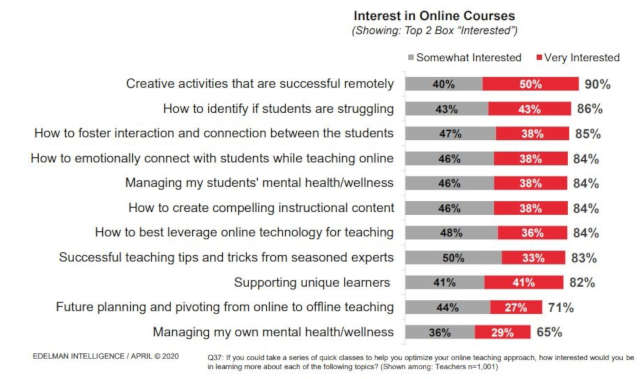Educators Feeling Stressed, Anxious, Overwhelmed and Capable
- By Dian Schaffhauser
- 06/02/20
More
than nine in 10 teachers (94 percent) shifted to remote teaching in
response to school closures. While most of those teachers that
haven't transitioned to online teaching (another four percent)
intended to do so, among the tiny share that haven't and won't, the
primary reasons they gave were tied to lack of access to technology
and lack of support at home for their students. More than half in
that position (55 percent) said they were handing out paper materials
to parents for students to use at home.
Among
those who did switch to online teaching, respondents said they spent
almost as much time preparing for their virtual classes (three hours)
as they did teaching them (four hours).

What
kinds of "quick classes" teachers would like to optimize their online teaching practices. Source: "University of Phoenix:
Virtual Teaching Academy Research from University
of Phoenix
Those
findings came out of an extensive online survey of American K-12
teachers between Apr. 10 and Apr. 13, 2020. About a thousand people
responded to the survey, which was sponsored by the University
of Phoenix,
an online institution that has a College
of Education,
and reported by Edelman
Intelligence.
The primary objectives of the survey were to understand where
teachers were experiencing successes, challenges and unfilled needs
as they moved to virtual instruction, as well as their state of
mental health, what resources and tools they had or wished they had
and what content would help them succeed with online instruction.
Unsurprisingly,
the majority of teachers reported that they feel "somewhat"
or "extremely" uncertain (81 percent), stressed (77
percent), anxious (75 percent), overwhelmed (74 percent), sad (60
percent) and lonely (54 percent). On the other hand, they also are
feeling capable (77 percent), motivated (66 percent) and confident
(61 percent). Overall, however, they have greater confidence in their
own abilities to adjust to virtual instruction than they do in their
students' abilities to do so (81 percent compared to 57 percent).
When
asked how the transition "made you feel," one high school
teacher responded, "Slightly anxious to be out of my comfort
zone. Thankful to still be able to work. Glad to learn new
skills/software. Glad to still communicate with students. Worried for
safety and health of students." Those sentiments were countered
by another high school teacher who offered this response: "Frustrated
and exhausted. We did not have transitional time, nor did we have a
grace period to test out methods. Our school district wanted us to
have it perfect within hours. So I felt unsupported and definitely
unappreciated."
When
it comes to coping with their own mental health, teachers said they
were more likely to turn to friends and family (75 percent), walks
(73 percent), and conversations with peer teachers (61 percent) than
they were to look for support from their significant other (57
percent).
Any
sense of responsibility that these educators feel to doing their jobs
isn't necessarily coming from their bosses. Just 15 percent said
school leaders were "pressuring" them "to stay on
track." Two-thirds (67 percent) pointed to "internal
pressure" as the motivator "to do right by the students
[and] stay on track."
What
weighs most heavily on them is their students' overall well-being.
Nine in 10 agreed that the lack of face-to-face connection with
students was making the transition "more difficult."
Teachers also said that the lack of social time students had with
each other was hurting student personal growth and that virtual
teaching hindered their own abilities "to identify if students
[were] struggling."
If
teachers could take quick courses to help them optimize their online
instructional practices, the greatest interest focused on helping
them come up with creative activities that could be done remotely (90
percent). But following that, the focus was on how to work best with
students: identifying whether they were struggling (86 percent),
fostering interaction and better connections between the students (85
percent), connecting better with students emotionally while teaching
online (84 percent) and managing their students' mental health (84
percent). Similarly high numbers of respondents said they would like
to learn more about how to create compelling lesson content (84
percent) and use online technology for teaching (84 percent).
While
the full report isn't available online yet, the University of Phoenix
expected to post a version in the near future.
About the Author
Dian Schaffhauser is a former senior contributing editor for 1105 Media's education publications THE Journal, Campus Technology and Spaces4Learning.